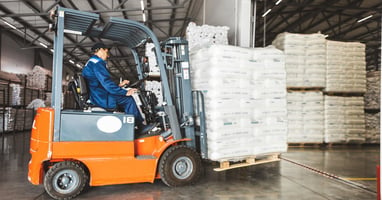Forklifts are essential for lifting and transporting goods of all sizes and weights. They operate...
Forklift Safety Tech: Wearables, Zone Control & Beyond
Forklift operators must follow all sorts of safety protocols: stopping at all intersections even if they don't see anyone coming, slowing in designated areas, honking, and having headlights on their vehicle, yet accidents still sometimes occur.
To help take the burden off of the driver, some top-of-the-line forklifts have vision systems and artificial intelligence controls. However, implementing that advanced setup is prohibitively expensive for many businesses.
That's where tools like Lopos Smart Proximity Detectors and others fit in. Using Ultra Wide Band technology, they get the job done just as well, drastically improving forklift safety at a fraction of the cost.
- It's an affordable alternative to super high-end options and much faster to implement.
- Provides forklift-to-forklift protection, forklift-to-pedestrian protection, and zone control. Zone control allows the forklift to slow in designated areas automatically.
- Every aspect is entirely customizable by the client in moments.
- The software allows for remote updates and for the client to get actionable data to improve safety continuously.
Let's see it, along with an LED warning system in action in three real-world cases:
Roofing Manufacturer (speed control)
A large roofing company has a break room in their warehouse right in the middle of the action. There are bathrooms nearby, forklifts driving in front of the bathroom and breakroom doors, and many people walking while not always paying complete attention; a recipe for safety disaster. Using a zone beacon, the client set up a zone that extended 15 feet before and 15 feet after the danger area, where the forklift automatically reduces its speed to 2 MPH, thereby reducing the potential for dangerous collisions. This takes safety responsibility off of the driver; the driver doesn't have to remember; it's automatic. The driver doesn't have to be perfect or see everything to stay safe. And these added controls have proven to be a success so far.
Insulation Distributor (forklift-to-forklift)
An insulation company has large stacks of products in a staging area where multiple forklifts operate simultaneously. In the past, minor forklift-to-forklift collisions were commonplace due to the challenging layout and blind corners. The Lopos Collison Avoidance System alerts each forklift driver that someone is near even before they can see each other. The Ultra Wide Band Technology does not need a direct line of sight, so drivers can avoid accidents before seeing the other forklift.
Multinational Food Company (forklift-to-pedestrian, smart-proximity wearables)
At a global food company's facility, there are many tours given and areas in the manufacturing facility where forklifts and pedestrians work in close proximity. But now, all employees and visitors are issued a small wearable device that accurately calculates distances, detects forklifts, and creates an invisible barrier for pedestrian protection. The client customizes the distances so that when a forklift and pedestrian break the invisible barrier, the driver and the pedestrian are alerted. Now, the driver and pedestrian are responsible for their safety and can react accordingly when an alert is given.

These are just three scenarios of how companies are taking forklift safety into the future. What forklift safety challenge are you facing? There's likely a viable solution that's ready to deploy, and it probably won't break the bank.
Looking to upgrade your forklift safety tech at a reasonable price? Logimate can get you there. Book a call with Brian today to talk forklifts and warehouse safety products. We might even be able to come out and demonstrate some of them for you on-site.




